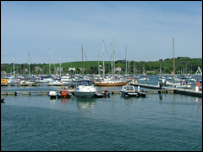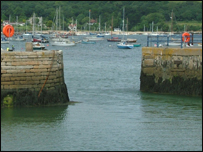
 Coastal
Cornwall
Coastal
Cornwall
Falmouth Coast Walk

 |
||
 |
||
 |
||
 |
||
 |
||
 |
||
 |
||
 |
||
 |
||
 |
||
 |
||
Inside Custom House Quay
|
Stage 3- Custom House Quay For 150 years, Falmouth was the only place where the mail came in and out of the country - in The Packet Ships. If you were the captain of one of the ships you would land at Customs House Quay, our next stop for the online walk.
This was where the Royal Mail established its packet service – where mail came in and out of the country. Falmouth is not only one of the best natural harbours in the South West, it’s also ideally placed for sailing ships returning home on those prevailing westerly winds – and far enough from the French and other dastardly continentals desperate to intercept our mails. A narrow lane leads to the quay In 1689, Falmouth was chosen as the base for a scheduled Government route to Corunna in Spain. A Post Office agent ran the service in Falmouth. The mails were delivered from London, first by post and later by mail coach, and transported on packet ships chartered by the Post Office. Agents and captains were allowed to transport bullion and a few important passengers, as well as undertaking some trading on their own behalf. Carrying cargo, however, was forbidden. This ban was sometimes ignored, and many officers and crew made money by illicit trading. By 1702 packet ships were sailing regularly to Lisbon in Portugal and to Barbados and Jamaica in the West Indies. New York was added in 1755, and by 1784, packets were serving Gibraltar and several ports in the American colonies. Routes were opened up to South America and into the Mediterranean at the beginning of the 19th century. The mails for India were taken to Alexandria, where an overland link to the Red Sea was established in 1835. The entrance was too narrow for Packets The packet ships were little two masted brigs. They were fast, carrying square sails, a long bowsprit, headsails and a large gaff mizzen-sail. They attracted the attention of pirates, and carried guns on board – however, they were under strict instructions from the Royal Mail to use them only for self-defence. By the 1800s, a fleet of around 40 packet ships were operating out of Falmouth. Falmouth then flourished for 200 years as the second busiest port of the British Empire. Because these letters weren’t just holiday postcards and round robins – the boats carried vital and often secret intelligence from the four corners of the Empire back to the mother country. The ships had special weights so the captains could sink their cargoes if they came under attack. For the same reason, the packet ships were built for speed – nippy little things that, if push came to shove, could usually outrun a lumbering 'man-o-war'. In it’s heyday, 3000 ships a year passed through Falmouth. The ship agents doubled as consulates attending to the needs of ambassadors, adventurers, prosperous merchants and desperate refugees from practically every country on the globe. Steam was Falmouth’s undoing. The steamships were faster and more reliable than the old sailing packets. And they had no problem reaching London whatever the wind. By 1850 Falmouth’s place as the start of the information superhighway was over. Head away from the car park and up the ramp back on to the main
road. Turn right. Walk down the street until you reach The Falmouth
Arts Centre which will be on your left. This building, also known
locally as The Poly, is the next stage of the walk. Continue your walk: Stage
4: Royal Cornwall Polytechnic
|
Coastal Cornwall, Harbour's Reach, King Charles Quay, Falmouth, Cornwall TR11 3HQ
E-mail:info@coastal-cornwall.co.uk Web site design by Slice Internet of Cornwall


